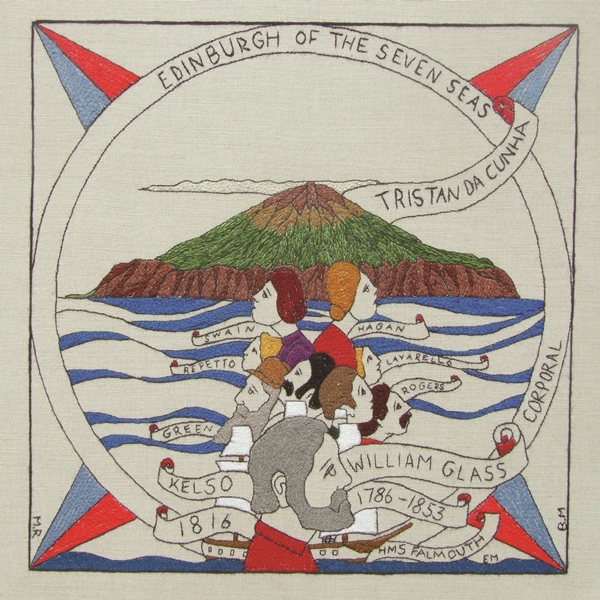Stitchers: Elaine Mawer (Glasgow), Betty Mawer (Milngavie), Margaret Repetto (Tristan da Cunha)
Out in the South Atlantic Ocean, 1,750 miles from South Africa and reachable only by boat, the residents of Tristan da Cunha live a unique life. The island covers approximately 38 square miles, being just 7 miles long. Its highest point is Queen Mary’s Peak at 6,765ft above sea level. The climate is temperate and oceanic, with rapid weather changes sometimes resembling four seasons in one day – something some parts of Scotland could relate to. Tristan da Cunha is the largest of a group of islands which are known collectively by the same name; the island of Inaccessible lies 20 miles to the west, Nightingale 25 miles to the south west, and Gough 220 miles to the south. Gough and Inaccessible are world heritage sites of which the Tristan community is very proud.
The island was discovered in 1506 by the Portuguese Admiral Tristao da Cunha who named it after himself, although it was nearly a century and a half before there was a recorded landing there. The island was settled in 1816 by William Glass from Kelso in Scotland, who arrived with the British Garrison which intended to prevent the island being used by French or American naval forces. After the garrison left, Glass decided to stay with his wife and children. The community grew from shipwreck sailors and people who visited the island and decided to stay and marry.
The main settlement is known as Edinburgh of the Seven Seas in honour of Prince Alfred, Duke of Edinburgh, who visited the island in 1867. There is only one pub, one shop, one Post Office and one school. The only bank which exists still deals exclusively in hard cash, which was only introduced to the island in 1942. There are two churches on the island: St Mary’s Church practices the Anglican faith; St Joseph’s Church practices the Catholic faith.
The islanders rely on farming and fishing, with the main revenue earned by the lobster fishery. They grow their own potatoes and keep cattle and sheep for milk, meat and wool. Wool from the sheep is carded and spun for knitting yarn. Knitting is so popular that the island has its own knitting brand called ‘37 Degrees South’. The unique island dialect of English is born from the mix of British, American, St Helenian (Creole), Dutch, Italian and Afrikaans language.
In 1961 a volcanic eruption occurred at the Tristan settlement which led to the evacuation of the entire community to the UK. The islanders yearned to return home so in 1962 an advance party of 6 headed to Tristan to make ready for the islanders return. In 1963 the islanders were able to return home to their beloved Tristan.
 Dùn Èideann nan Seachd Cuantan Is e Tristan da Cunha an t-eilean le daoine as iomallaiche air an t-saoghal, le mu 264 luchdcòmhnaidh. Stèidhichte anns a’ Chuan Siar a Deas, 1750 mìle bho Afraga a Desa, is e an teilean as motha den bhuidheann. Lorgadh an t-eilean ann an 1506 leis an admarail Portagaileach Tristao da Cunha, agus chaidh a thuineachadh ann an 1816 leis an Albannach, an Corpailear Uilleam Glass. Dh’fhàs a’ choimhearsnachd le seòladairean bho longan-briste. Thadhail am Prionnsa Alfred, Diùc Dhùn Èideann, ann an 1867 agus mar chuimhneachan air an sin tha baile beag Dhùn Èideann de na Seachd Cuantan air ainmeachadh. Is e coimhearsnachd tuathanachais agus iasgaich a th’ ann far a bheil an luchd-còmhnaidh a’ labhairt Beurla ann an dualchainnt freumhaichte ann am mòran nàiseantachdan.
Dùn Èideann nan Seachd Cuantan Is e Tristan da Cunha an t-eilean le daoine as iomallaiche air an t-saoghal, le mu 264 luchdcòmhnaidh. Stèidhichte anns a’ Chuan Siar a Deas, 1750 mìle bho Afraga a Desa, is e an teilean as motha den bhuidheann. Lorgadh an t-eilean ann an 1506 leis an admarail Portagaileach Tristao da Cunha, agus chaidh a thuineachadh ann an 1816 leis an Albannach, an Corpailear Uilleam Glass. Dh’fhàs a’ choimhearsnachd le seòladairean bho longan-briste. Thadhail am Prionnsa Alfred, Diùc Dhùn Èideann, ann an 1867 agus mar chuimhneachan air an sin tha baile beag Dhùn Èideann de na Seachd Cuantan air ainmeachadh. Is e coimhearsnachd tuathanachais agus iasgaich a th’ ann far a bheil an luchd-còmhnaidh a’ labhairt Beurla ann an dualchainnt freumhaichte ann am mòran nàiseantachdan.

